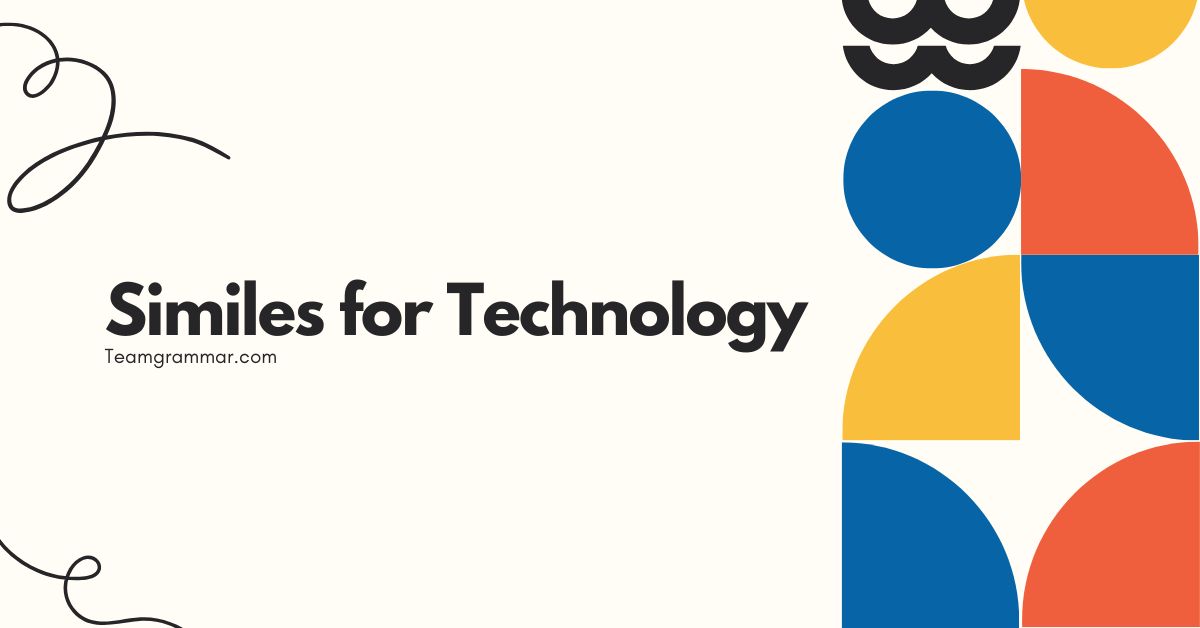35 Similes for Technology: Enhancing Descriptions with Figurative Language
Understanding similes is crucial for enriching your descriptive writing, especially when discussing complex topics like technology. Similes allow you to draw comparisons between the familiar and the unfamiliar, making intricate technological concepts more accessible and engaging.
This article will explore the use of similes in the context of technology, providing you with a comprehensive guide to crafting vivid and relatable descriptions. Whether you’re a student, writer, or simply someone interested in improving your communication skills, this guide will equip you with the knowledge and tools to effectively use similes to describe technology.
| Table of Contents |
|---|
Definition of Similes
A simile is a figure of speech that compares two different things using the words “like” or “as.” Its primary function is to make a description more vivid, relatable, and understandable by drawing a parallel between something familiar and something less so. Similes help to create a mental image in the reader’s mind, making abstract concepts more concrete.
In the context of technology, similes can be particularly useful for explaining complex systems, processes, or devices in a way that is easily grasped by a non-technical audience.
Similes are classified as a type of figurative language, specifically a type of comparison. They differ from metaphors, which directly equate two things (e.g., “The internet is a highway”).
Similes, on the other hand, acknowledge the difference between the two things being compared while highlighting their similarities (e.g., “The internet is like a highway”). The contexts in which similes are used are vast, ranging from literature and poetry to everyday conversation and technical writing.
Structural Breakdown of Similes
The basic structure of a simile consists of three key elements: the subject (the thing being described), the linking word (“like” or “as”), and the object of comparison (the thing to which the subject is being compared). Understanding this structure is crucial for constructing effective and clear similes.
The subject is the technological element you’re trying to describe. This could be anything from a computer program to a network system.
The linking word, “like” or “as,” explicitly signals that a comparison is being made. The object of comparison should be something familiar to the audience, allowing them to easily understand the subject’s characteristics.
For instance, in the simile “A computer virus spreads like wildfire,” the subject is “computer virus,” the linking word is “like,” and the object of comparison is “wildfire.” This structure makes the rapid and destructive nature of a computer virus easily understandable.
Let’s consider some additional examples to further illustrate the structural components:
- Subject: Cloud storage; Linking Word: like; Object of Comparison: a vast, unlimited warehouse.
- Subject: A software update; Linking Word: as; Object of Comparison: a fresh coat of paint.
- Subject: Artificial intelligence; Linking Word: like; Object of Comparison: a continuously learning student.
Types of Similes Used in Technology
Similes used in technology can be categorized based on the aspect of technology they emphasize or the type of comparison they make. Here are a few common types:
Similes Highlighting Speed
These similes emphasize the rapid pace or quickness of a technological process or device. They often compare the speed of technology to fast-moving objects or phenomena.
Similes Highlighting Efficiency
These similes focus on how effectively a technology performs its function, often comparing it to well-oiled machines or streamlined processes.
Similes Highlighting Complexity
These similes emphasize the intricate and multifaceted nature of technological systems, comparing them to complex structures or puzzles.
Similes Highlighting Reliability
These similes highlight the dependability and robustness of technology, comparing them to steadfast objects or unwavering forces.
Similes Highlighting User Experience
These similes focus on the ease and intuitiveness of using a particular technology, comparing it to simple, user-friendly tools or experiences.
Examples of Similes for Technology
Here are some examples of similes, categorized by the aspect of technology they highlight. Each category includes a range of similes to provide a comprehensive understanding of their application.
Similes Highlighting Speed
The following table provides examples of similes that emphasize the speed of various technological processes. These comparisons help to illustrate how quickly technology can operate.
| Simile | Explanation |
|---|---|
| The data transferred as fast as lightning. | Implies extremely quick data transmission. |
| The processor runs like a race car. | Compares the processor’s speed to a very fast vehicle. |
| The website loaded as quickly as a blink of an eye. | Highlights the immediate loading time of the website. |
| Downloading the file was as swift as an arrow. | Illustrates the rapid download speed. |
| The algorithm processed the information like a rocket launching. | Emphasizes the algorithm’s fast processing capability. |
| His fingers flew across the keyboard like a hummingbird’s wings. | Describes very fast typing speed. |
| The supercomputer crunched numbers as fast as a cheetah runs. | Compares the computer’s processing speed to the fastest land animal. |
| The network connection was as quick as a flash. | Highlights the speed of the network connection. |
| The program executed the instructions like a bullet from a gun. | Emphasizes the rapid execution of instructions. |
| The search engine retrieved the results as fast as thought. | Illustrates the near-instantaneous retrieval of search results. |
| The new software installed as quickly as you can snap your fingers. | Highlights the ease and speed of the installation process. |
| The system rebooted as fast as a hiccup. | Illustrates the very short time it takes for the system to restart. |
| The code compiled like a shot. | Emphasizes the rapid compilation of the code. |
| The application responded as swiftly as a striking snake. | Illustrates the immediate response of the application. |
| The robotic arm moved as fast as a striking cobra. | Highlights the agility and speed of the robotic arm. |
| The printer produced pages as fast as a machine gun fires. | Compares the printer’s speed to a rapid-firing weapon. |
| The website updated as quickly as the news spreads. | Illustrates the speed of website updates. |
| The file uploaded as fast as a satellite orbiting Earth. | Compares the upload speed to the high velocity of a satellite. |
| The data was encrypted as quickly as a magician’s trick. | Highlights the seemingly instantaneous encryption process. |
| The program ran as fast as greased lightning. | Emphasizes the exceptional speed of the program. |
| The download was as quick as a pit stop in Formula 1. | Highlights the speed of the download process. |
| The transaction processed as fast as a rumour spreads. | Compares the transaction speed to the rapid spread of rumors. |
| The software update installed as quickly as a breath. | Illustrates the near-instantaneous installation. |
| The information traveled as fast as the speed of light. | Emphasizes the extreme speed of information transfer. |
Similes Highlighting Efficiency
The table below presents similes that underscore the efficiency of various technological tools and systems. These comparisons are useful for explaining how well technology performs its intended functions.
| Simile | Explanation |
|---|---|
| The software worked like a well-oiled machine. | Implies smooth and efficient operation. |
| The algorithm sorted the data as efficiently as a librarian. | Compares the algorithm’s efficiency to a highly organized librarian. |
| The system runs as smoothly as a hot knife through butter. | Highlights the seamless and efficient operation of the system. |
| The program executed its tasks like a finely tuned engine. | Illustrates the precise and efficient execution of tasks. |
| The database organized the information as neatly as a filing cabinet. | Emphasizes the organized and efficient storage of information. |
| The server processed requests as efficiently as a busy airport. | Compares the server’s processing efficiency to a well-managed airport. |
| The code ran as cleanly as a whistle. | Highlights the smooth and efficient execution of the code. |
| The operating system managed resources like a skilled conductor. | Illustrates the efficient management of resources by the operating system. |
| The application handled the workload as efficiently as a factory production line. | Emphasizes the application’s ability to handle a large workload efficiently. |
| The network distributed the data as smoothly as a flowing river. | Illustrates the seamless distribution of data across the network. |
| The program ran as efficiently as a Swiss watch. | Highlights the precision and efficiency of the program’s operation. |
| The robotic arm worked as precisely as a surgeon’s hand. | Compares the robot’s precision to the skill of a surgeon. |
| The software optimized the process as effectively as a seasoned manager. | Illustrates the software’s ability to optimize processes efficiently. |
| The new system integrated as seamlessly as pieces of a puzzle fitting together. | Highlights the easy and smooth integration of the new system. |
| The machine performed its function as reliably as the rising sun. | Illustrates the dependable and efficient performance of the machine. |
| The application performed its tasks as efficiently as a bee collecting nectar. | Compares the app’s efficiency to the diligent work of a bee. |
| The process flowed as smoothly as a well-choreographed dance. | Emphasizes the seamless and efficient flow of the process. |
| The workflow was as streamlined as a modern assembly line. | Illustrates the efficient and organized nature of the workflow. |
| The system operated as harmoniously as a well-tuned orchestra. | Highlights the coordinated and efficient operation of the system. |
| The data mining tool sifted through the information as thoroughly as a gold prospector. | Compares the tool’s thoroughness to that of a gold prospector. |
| The software upgrade ran as smoothly as a new coat of paint. | Highlights the improved and seamless operation after the upgrade. |
| The automated system worked as tirelessly as a diligent worker. | Illustrates the system’s continuous and efficient operation. |
| The network operated as predictably as clockwork. | Emphasizes the reliable and efficient operation of the network. |
| The security system worked as vigilantly as a hawk. | Compares the system’s vigilance to the sharp-eyed watchfulness of a hawk. |
Similes Highlighting Complexity
The following table presents similes to describe the complexity of various technologies. These comparisons can help make intricate systems seem more approachable by relating them to familiar complex structures.
| Simile | Explanation |
|---|---|
| The network architecture is like a complex spiderweb. | Implies an intricate and interconnected system. |
| The algorithm is as complex as a human brain. | Compares the algorithm’s complexity to the human brain. |
| The code was as tangled as a ball of yarn. | Highlights the complicated and messy nature of the code. |
| Understanding the system is like navigating a maze. | Illustrates the difficulty in comprehending the system. |
| The software architecture is as intricate as a cathedral. | Emphasizes the detailed and complex design of the software. |
| The firmware is as complicated as a clock’s inner workings. | Compares the firmware’s complexity to the detailed mechanism of a clock. |
| The program’s structure is like a house of cards. | Highlights the delicate and easily disrupted nature of the program. |
| The system’s design is as convoluted as a labyrinth. | Illustrates the intricate and difficult-to-navigate design of the system. |
| The database schema is as elaborate as an ancient map. | Emphasizes the detailed and complex structure of the database. |
| The security protocol is as layered as an onion. | Highlights the multiple layers of security protection. |
| The software project became as unwieldy as a hydra. | Implies that the project had many complex and uncontrollable parts. |
| The system’s logic is as inscrutable as hieroglyphics. | Compares the system’s logic to the difficulty of deciphering ancient writing. |
| The network topology is as intricate as a neural network. | Highlights the detailed and interconnected structure of the network. |
| The system architecture is as complex as a Rube Goldberg machine. | Implies an overly complicated and inefficient design. |
| The programming language is as nuanced as a musical score. | Compares the language’s complexity to the subtleties of a musical composition. |
| The interactions between the components are like a complex dance. | Illustrates the coordinated but intricate relationships between components. |
| The information architecture is as layered as a geologic formation. | Emphasizes the deep and complex structure of the information. |
| The code base is as extensive as an encyclopedia. | Highlights the vast amount of code within the project. |
| The algorithm’s steps are as carefully orchestrated as a ballet. | Compares the algorithm’s precise steps to a choreographed dance. |
| The system’s security is as fortified as a medieval castle. | Emphasizes the strong and layered security measures. |
| The debugging process is as challenging as solving a Rubik’s Cube. | Illustrates the difficulty in finding and fixing errors in the code. |
| The data structure is as multifaceted as a diamond. | Highlights the many aspects and complexities of the data structure. |
| The system is interconnected like the roots of a tree. | Emphasizes the deep and widespread connections within the system. |
| The API documentation is as dense as a legal document. | Compares the documentation’s density to the complexity of legal language. |
Usage Rules for Similes
When using similes, there are several rules to keep in mind to ensure clarity and effectiveness:
- Ensure Relevance: The comparison should be relevant to the characteristic you are trying to highlight.
- Avoid Clichés: Opt for fresh and original comparisons instead of overused similes.
- Maintain Clarity: The object of comparison should be easily understood by your audience.
- Be Concise: Keep your similes brief and to the point.
- Consider Your Audience: Tailor your similes to the knowledge and understanding of your audience.
Exceptions and Special Cases: While clarity is generally preferred, sometimes a slightly obscure simile can be effective if it adds a layer of intrigue or humor. However, use this sparingly and ensure it doesn’t detract from the overall understanding.
Common Mistakes When Using Similes
One common mistake is using clichés. For example, saying “The computer runs as slow as molasses” is a cliché and lacks originality.
A better simile might be “The computer runs as slow as a dial-up modem in the age of fiber optics.”
Another mistake is using similes that don’t make sense or are confusing. For example, “The code is like a bicycle” doesn’t provide a clear comparison unless you elaborate on which aspect of the code is similar to a bicycle (e.g., “The code is like a bicycle, requiring constant maintenance to keep it running smoothly”).
Here are some correct vs. incorrect examples:
| Incorrect | Correct | Explanation |
|---|---|---|
| The software is like a thing. | The software is like a well-oiled machine. | The incorrect simile is too vague. The correct simile provides a specific comparison. |
| The internet is as fast as fast. | The internet is as fast as a race car. | The incorrect simile is redundant. The correct simile provides a concrete comparison. |
| The program is like good. | The program is like a finely tuned instrument. | The incorrect simile is too general. The correct simile offers a specific and descriptive comparison. |
| The database is as big as big. | The database is as big as the Library of Congress. | The incorrect simile is redundant. The correct simile provides a measurable and understandable comparison. |
| The computer is like stuff. | The computer is like a central nervous system. | The incorrect simile is vague and meaningless. The correct simile provides a specific and relevant comparison. |
Practice Exercises
Test your understanding of similes with these practice exercises. Fill in the blanks to complete the similes, or rewrite the sentences using a simile.
Exercise 1: Fill in the Blanks
| Question | Answer |
|---|---|
| 1. The new laptop is as light as a __________. | feather |
| 2. The software update went as smoothly as __________. | a hot knife through butter |
| 3. The server is as reliable as __________. | the rising sun |
| 4. The internet connection was as slow as __________. | molasses in January |
| 5. The program ran as fast as __________. | a rocket |
| 6. The data was encrypted as securely as __________. | Fort Knox |
| 7. The new interface is as intuitive as __________. | using a smartphone |
| 8. The system crashed as unexpectedly as __________. | a lightning strike |
| 9. The algorithm is as complex as __________. | a maze |
| 10. The robotic arm moves as precisely as __________. | a surgeon’s hand |
Exercise 2: Rewrite Using Similes
| Question | Answer |
|---|---|
| 1. The computer processes data very quickly. | The computer processes data as fast as lightning. |
| 2. The new software is easy to use. | The new software is as easy to use as a smartphone. |
| 3. The network is very secure. | The network is as secure as a vault. |
| 4. The program runs efficiently. | The program runs like a well-oiled machine. |
| 5. The system is very complex. | The system is as complex as a spiderweb. |
| 6. The server is extremely reliable. | The server is as reliable as the rising sun. |
| 7. The download was very fast. | The download was as fast as a rocket launching. |
| 8. The data was organized neatly. | The data was organized as neatly as a filing cabinet. |
| 9. The code was difficult to understand. | The code was as tangled as a ball of yarn. |
| 10. The computer is very light. | The computer is as light as a feather. |
Advanced Topics in Similes
For advanced learners, explore the use ofextended similes, where the comparison is developed over multiple sentences or even paragraphs. This technique can add depth and nuance to your descriptions, creating a more immersive experience for the reader.
Additionally, consider experimenting withunconventional similes, which draw comparisons between seemingly unrelated things to create a surprising and thought-provoking effect. However, use these techniques judiciously, ensuring that they enhance rather than obscure your message.
Another advanced topic is the use of similes to createspecific tones. For example, comparing a new technology to something ancient can create a tone of irony or humor.
Comparing a technology to nature can create a sense of harmony or ecological awareness. Understanding how similes can influence tone can allow you to craft more impactful and nuanced writing.
Frequently Asked Questions
- What is the difference between a simile and a metaphor?
A simile compares two things using “like” or “as,” while a metaphor directly equates two things without using these words. For example, “The internet is like a highway” (simile) vs. “The internet is a highway” (metaphor).
- Why are similes useful in describing technology?
Similes make complex technological concepts more accessible and understandable by comparing them to familiar things. They help create a mental image and make abstract ideas more concrete.
- How can I avoid using clichés in my similes?
Think creatively and try to find original comparisons that haven’t been overused. Consider specific details and unique characteristics of the technology you’re describing.
- What should I do if my simile is confusing to the audience?
Re-evaluate your comparison and ensure that the object of comparison is easily understood by your target audience. Provide additional context or explanation if necessary.
- Can a simile be too long?
Yes, a simile should be concise and to the point. Avoid overly lengthy or convoluted comparisons that detract from the clarity of your message. Extended similes can work, but use them sparingly.
- How do I choose the right object of comparison for my simile?
Consider the key characteristics you want to highlight and choose an object of comparison that shares those characteristics in a clear and relatable way. Also, consider your audience and what they will understand.
- Is it okay to use similes in formal technical writing?
Yes, but use them judiciously. Similes can be effective for explaining complex concepts to a non-technical audience, but avoid using them in highly technical sections where precision is paramount.
- How do I create a simile that is both creative and clear?
Start by identifying the key characteristic you want to emphasize. Then, brainstorm a list of potential objects of comparison. Choose the one that is both original and easily understood by your audience.
- Can similes be used to describe negative aspects of technology?
Yes, similes can be used to describe both positive and negative aspects. For example, “The system crashed like a house of cards” highlights the instability of the system.
- What role does context play in the effectiveness of a simile?
Context is crucial. A simile that works well in one context may be confusing or inappropriate in another. Always consider the overall tone and purpose of your writing when using similes.
Conclusion
Mastering the use of similes is a valuable skill for anyone seeking to communicate effectively about technology. By drawing meaningful comparisons, you can make complex concepts more accessible, engaging, and memorable for your audience.
Remember to focus on relevance, clarity, and originality when crafting your similes, and always consider your audience’s knowledge and understanding. With practice, you can harness the power of similes to elevate your writing and communication skills to new heights.
As a final learning tip, actively read and analyze how other writers use similes in their descriptions of technology. Pay attention to the comparisons they make, the language they use, and the overall effect they achieve.
By studying successful examples, you can gain valuable insights and inspiration for your own writing.







